Location, Location, Location: Establishing Design Principles for New Antibacterials from Ferric Siderophore Transport Systems
- PMID: 39202968
- PMCID: PMC11357680
- DOI: 10.3390/molecules29163889
Location, Location, Location: Establishing Design Principles for New Antibacterials from Ferric Siderophore Transport Systems
Abstract
This review strives to assemble a set of molecular design principles that enables the delivery of antibiotic warheads to Gram-negative bacterial targets (ESKAPE pathogens) using iron-chelating siderophores, known as the Trojan Horse strategy for antibiotic development. Principles are derived along two main lines. First, archetypical siderophores and their conjugates are used as case studies for native iron transport. They enable the consideration of the correspondence of iron transport and antibacterial target location. The second line of study charts the rationale behind the clinical antibiotic cefiderocol. It illustrates the potential versatility for the design of new Trojan Horse-based antibiotics. Themes such as matching the warhead to a location where the siderophore delivers its cargo (i.e., periplasm vs. cytoplasm), whether or not a cleavable linker is required, and the relevance of cheaters to the effectiveness and selectivity of new conjugates will be explored. The effort to articulate rules has identified gaps in the current understanding of iron transport pathways and suggests directions for new investigations.
Keywords: Trojan Horse; antibiotics; cefiderocol; iron transport; siderophore.
Conflict of interest statement
The authors declare no conflicts of interest.
Figures


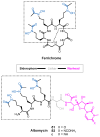


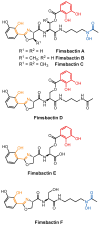



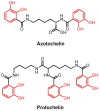

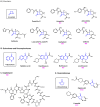






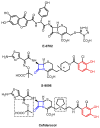
Similar articles
-
[Discovery of a New Siderophore Cephalosporin, Cefiderocol].Yakugaku Zasshi. 2024;144(6):627-631. doi: 10.1248/yakushi.23-00197-1. Yakugaku Zasshi. 2024. PMID: 38825471 Review. Japanese.
-
Exploring the Antibacterial Activity and Cellular Fates of Enterobactin-Drug Conjugates That Target Gram-Negative Bacterial Pathogens.Acc Chem Res. 2024 Apr 2;57(7):1046-1056. doi: 10.1021/acs.accounts.3c00814. Epub 2024 Mar 14. Acc Chem Res. 2024. PMID: 38483177 Free PMC article.
-
Siderophore-Antibiotic Conjugate Design: New Drugs for Bad Bugs?Molecules. 2019 Sep 11;24(18):3314. doi: 10.3390/molecules24183314. Molecules. 2019. PMID: 31514464 Free PMC article. Review.
-
Siderophore-drug complexes: potential medicinal applications of the 'Trojan horse' strategy.Trends Pharmacol Sci. 2014 Sep;35(9):442-9. doi: 10.1016/j.tips.2014.06.007. Epub 2014 Aug 6. Trends Pharmacol Sci. 2014. PMID: 25108321 Review.
-
The Role of Iron and Siderophores in Infection, and the Development of Siderophore Antibiotics.Clin Infect Dis. 2019 Nov 13;69(Suppl 7):S529-S537. doi: 10.1093/cid/ciz825. Clin Infect Dis. 2019. PMID: 31724044 Free PMC article.
References
-
- Centers for Disease Control and Prevention Antibiotic Resistance Threats in the United States, 2019. [(accessed on 17 July 2024)]; Available online: https://stacks.cdc.gov/view/cdc/82532.
-
- Magiorakos A.P., Srinivasan A., Carey R.B., Carmeli Y., Falagas M.E., Giske C.G., Harbarth S., Hindler J.F., Kahlmeter G., Olsson-Liljequist B., et al. Multidrug-Resistant, Extensively Drug-Resistant and Pandrug-Resistant Bacteria: An Interna-tional Expert Proposal for Interim Standard Definitions for Acquired Resistance. Clin. Microbiol. Infect. 2012;18:268–281. doi: 10.1111/j.1469-0691.2011.03570.x. - DOI - PubMed
-
- World Health Organization WHO Bacterial Priority Pathogens List, 2024: Bacterial Pathogens of Public Health Importance to Guide Research, Development and Strategies to Prevent and Control Antimicrobial Resistance. [(accessed on 11 July 2024)]. Available online: https://www.who.int/publications/i/item/9789240093461.
Publication types
MeSH terms
Substances
LinkOut - more resources
Full Text Sources
Medical
Molecular Biology Databases

